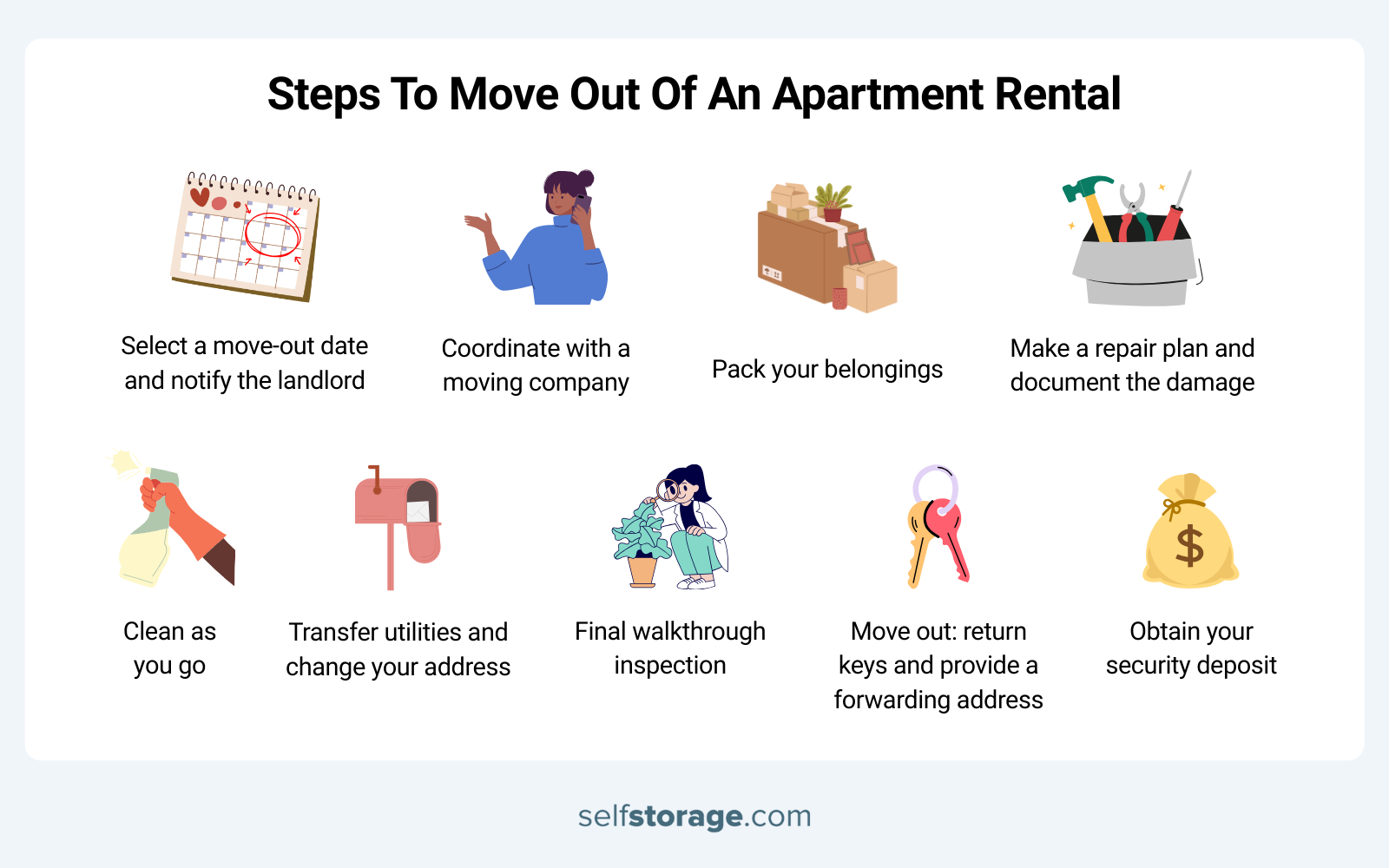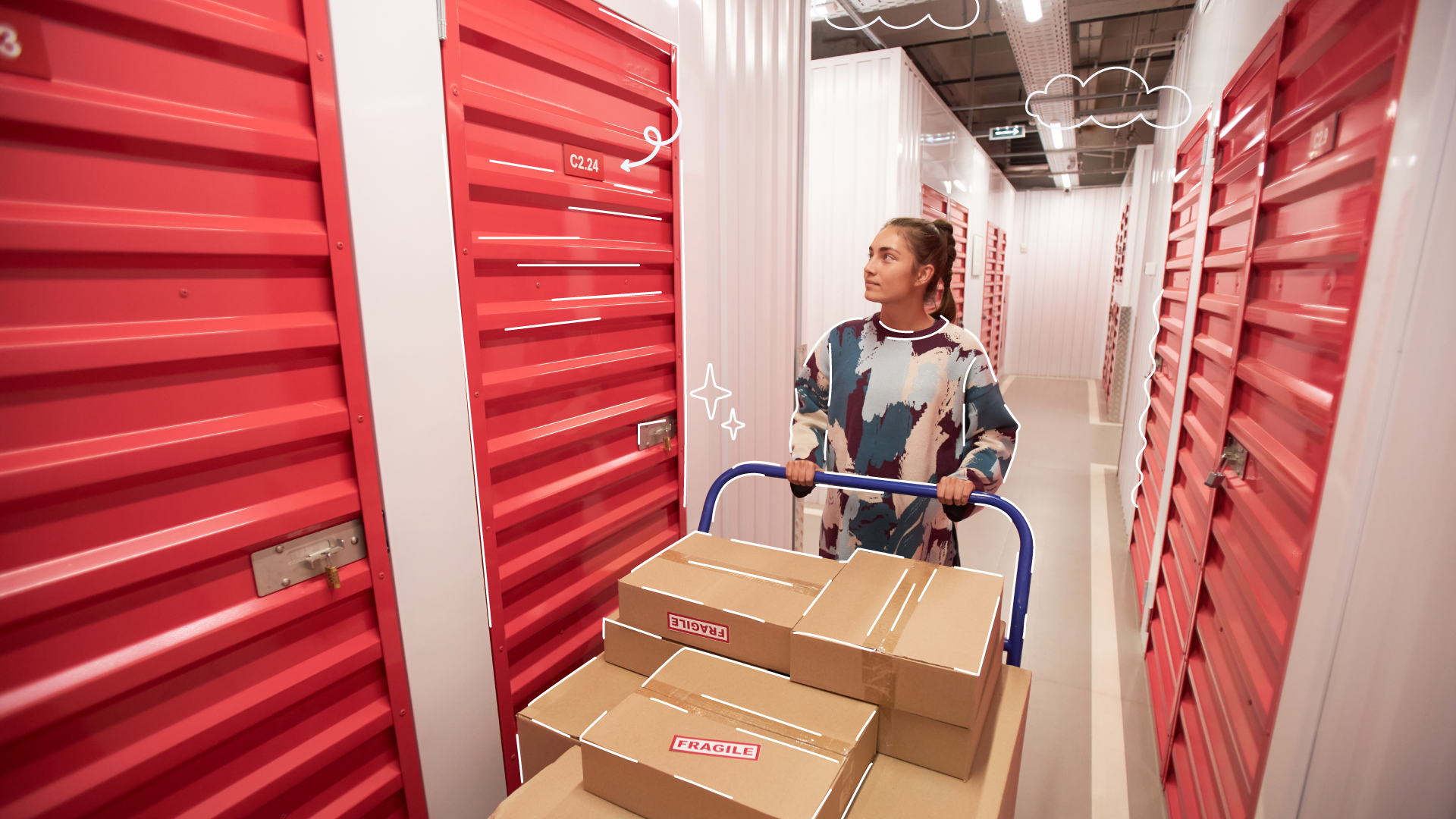Article takeaways
- Give your landlord or property manager a written move-out notice 30-60 days in advance, though it varies by lease, and include your planned move-out date, forwarding address, and contact information to maintain good landlord relations.
- Take photos/videos of the apartment’s condition before moving out, especially any pre-existing damage or normal wear and tear, to protect your security deposit from unfair deductions.
- As you pack, deep clean all areas, including hidden spots like inside cabinets, and handle small repairs like filling nail holes to avoid security deposit deductions.
- Schedule a walkthrough with your landlord, return all keys, double-check they have your forwarding address for the deposit, and know that landlords typically have 30 days to return deposits with itemized deduction lists if they took any money out for repairs.
When it comes to moving out of a rental, it’s a bit like breaking up. You want a clean break without any awkward confrontations with your property manager.
You want to give the other party a move-out notice before they catch you packing boxes while ensuring you get your “stuff” (security deposit) back without drama.
But moving out of an apartment doesn’t have to be painful. After all, moving out of a rental isn’t always the result of an eviction lawsuit.
Here’s a big-picture view of what the moving process involves, from giving your move-out notice to the pre-move-out inspection:
- Select a move-out date and give your property or landlord a written notice
- Pack your belongings well before moving day and plan for temporary storage if needed
- Document any damage or wear and tear
- Clean thoroughly and make minor repairs
- Do a final walkthrough inspection with your landlord or property manager and return the keys
- Leave a forwarding address to receive your security deposit
Read on for more detailed information about how you can move out of a rental apartment without hassle or unnecessary costs.
We’ll talk about a cleaning plan, making a packing list, and whether you should do it yourself or hire professional movers.
We’ll also reveal how SelfStorage.com can help you relocate on a moving budget.
Steps To Move Out Of An Apartment Rental

Moving out of a rental home or apartment is usually a major task, involving much more than just throwing things willy-nilly into boxes and leaving town. You want to protect your security deposit and ensure a strong recommendation from your landlord in the future.
This means you should follow proper move-out procedures, make necessary repairs to leave the rental property in good condition, and clean thoroughly before you turn over the keys.
It may seem daunting, but this “moving out of a rental” checklist will help make the process a breeze.
Select a move-out date and notify the landlord with enough notice
Once you’ve decided to leave your rental, it’s time to give your landlord or property manager your official move-out notice.
Typically, leases require 30 to 60 days’ notice before the end of the rental period, but you should check your lease agreement for the specific timeline.
That said, it’s a good idea to let them know as far before moving day as you can, so as to end your stay with them on good terms.
If you’re moving out before the end of the lease due to issues with the housing quality standards, property manager/landlord, or neighbors, check out our guide on how to break your lease without a penalty. You want to proceed with legal accuracy to be sure you’re not the one violating the rental agreement. This may require the counsel of professional legal help.
Regardless of whether you’re moving out in the middle of the rental agreement or at the end, the first step is still giving the landlord or property manager notice.
We suggest giving them a written notice, even if you tell the landlord in person, so you have it on record. Your written notice should include:
- Your planned move-out date: This is the day you intend to vacate the property completely
- A safe address for forwarding: For any future communication and the return of your security deposit check
- Contact information: In case your landlord needs to get in touch with you for any final arrangements or questions
Some landlords may require a specific form when tenants move out, while others will accept an email. Check your rental agreement for requirements.
Coordinate with a moving company
Unless you’ve chosen to move out on your own (or with the help of friends and family), the next step is to lock down a moving company.
There are benefits to both DIY moving, like a lower moving budget, and hiring a professional moving service, like saving time.
It can take a month or more to get on a professional mover’s schedule, especially in the busy summer months, or if you need additional moving services like help with the full packing process.
Choosing a full-service moving company is a big decision, so start comparing quotes and gathering information as soon as possible.
Make sure there is a several-day gap between the day the moving service company comes and the moving day established with your landlord. You will need time to deep clean and potentially do small repairs.
Pack your belongings
Don’t make the mistake of thinking that it’s time to rest once the moving day is set!
Savvy tenants know that a slow-and-steady approach to packing is far less stressful than leaving it all until the last minute.
We typically suggest you start the packing phase with a decluttering process, evaluating which items you’re ready to donate or throw out.
Who wants to pay to move things that are no longer needed?. So, starting weeks in advance and packing boxes a little each day is the way to go.
Label boxes, wrap fragile items carefully, and create a home inventory list as you go for each room to stay organized.
Renting a self-storage unit is a great option for simplifying your moving day logistics, giving you time in between moves, or providing a little extra space at home. Storage fees for an entire month are often lower than the cost of a truck rental for a single extra day.
You can save money in the long run by packing a little every day and staging it in a small storage unit. Then, on moving day, you simply load the goods from your storage unit to your truck rental and head to the new address.
And even if you do decide to hire professional movers instead of renting a truck and doing it yourself, having them move-packed and organized boxes from a storage unit to the new address saves time and money.
If you’re feeling overwhelmed, fear not. There are many detailed resources available online to guide your packing process.
For a first-time mover, it’s definitely worth it to do a little research and make a plan that fits your needs. If you’re ready to dive in, check out our guide on what to pack first.
Make a repair plan and document the damage
Most rental companies and landlords ask you to document the pre-existing damages during your move-in inspection. That way, you’re only responsible for the wear and tear that occurred during your stay there.
Check for any guidelines on repairs or minor damages in your lease. The landlord is typically required to repair permanent appliances like the oven and fridge.
You’re likely responsible for minor repairs, changing the batteries on your smoke detectors, and filling any nail holes in the wall. But keep in mind that your repair plan doesn’t have to include normal wear and tear.
“Normal wear and tear” in an apartment generally includes expected, minor deterioration from regular use, as opposed to damage from neglect or misuse.
You should not be charged for normal wear and tear. You will, however, be charged for damages you failed to address before you moved out.
Every lease is different, but we’ve listed some standard examples from each category below.
- Examples of normal wear and tear: minor scuffs on walls, fading of paint due to sunlight, light carpet wear in high-traffic areas, and mild scratches on wood floors
- Examples of damage: large holes in walls, broken fixtures, extensive carpet staining, broken windows
Document any existing damage that occurred due to regular wear and tear, as these should not be deducted from your security deposit. Also, be sure to mention damage that you found during your move-in inspection.
Use your smartphone to take pictures or videos, and if possible, obtain a copy of your initial move-in condition report to ensure you won’t be held responsible for pre-existing issues.
The best cleaning plan: clean as you go

One of the most important steps for securing your security deposit is leaving the rental clean and in good condition.
Deep clean your apartment by vacuuming carpets, scrubbing floors, wiping down surfaces, and removing any lingering odors.
Don’t forget hidden spots such as inside cabinets, under sinks, and behind appliances.
Cleaning as you go, instead of leaving everything for the last day, will reduce stress and ensure a thorough job.
Use this cleaning checklist for moving apartments to make sure everything gets done before the big day!
- Kitchen: Clean microwave, oven, and stove, wipe down countertops and cabinets, empty and clean the fridge and freezer
- Bathrooms: Scrub tubs, toilets, sinks, mirrors, and remove any soap scum buildup or mold
- Floors: Vacuum and mop all floors, and consider shampooing carpets if they’re soiled
- Windows and walls: Wipe down walls, dust baseboards, and clean windows
- Hidden areas: Clean inside cabinets, closets, under sinks, behind appliances, and ceiling fans
Pro tip: Some leases include hiring professional cleaners as part of the moving-out tenant responsibilities. If so, make sure you keep the receipt as proof that it was done!
Transfer utilities and change your address
It’s a good idea to set aside a morning or afternoon to make sure that the administrative side of your move is handled properly.
We’ve listed three tasks that are crucial to handle no matter what the circumstances. Note, there may be others depending on the details of your move.
- Fill out a change of address at the post office and set up a forwarding address for safekeeping.
- Update your address with banks, employers, and other important contacts. Don’t forget to subscribe to + save orders from Amazon and other subscription services.
- Contact utility companies and cancel or transfer services like internet, electricity, water, and gas. Coordinate shut-off dates, ideally on your last day in the rental.
- Contact your renters’ insurance company and let them know you’re moving. You may be able to keep your current insurance company, but depending on the location of the new address, you may have to find a new one.
Final walkthrough inspection
The final walkthrough with your landlord or property manager is the time to ensure that everything is in order and address any issues with your landlord in person.
Try to schedule the walkthrough for a time when you’re fully packed and have finished any cleaning and repairs.
During the walkthrough, point out any areas you repaired or cleaned, and document the condition of each room.
This is also your chance to review the landlord’s move-out checklist, if they have one, and ensure you’re both on the same page regarding the property’s condition.
Move-out day: return keys and provide a forwarding address
On move-out day, hand over the keys, fobs, garage door openers, or any other access devices as required by the landlord.
Be sure to provide your forwarding address so that your landlord knows where to send your security deposit check.
Obtain your security deposit
After you’ve moved out, your landlord typically has a set period (often 30 days) to return your security deposit. If there are deductions, your landlord must provide a list detailing each charge. Review these carefully to ensure that they align with your lease agreement.
If you disagree with any deductions, it’s best to communicate directly with your landlord to understand their reasoning and negotiate if needed.
Consider writing a letter disputing any charges you don’t think you should be responsible for, and explain why.
In some cases, contacting a tenants’ rights organization for professional legal help may be helpful if there is a dispute over the security deposit. If the landlord disputes your demand letter, you may have to go to small claims court.
How SelfStorage.com Can Help You Move Out of an Apartment Rental
Moving out of a rental can be a complex process, but by staying organized, making necessary repairs, and leaving the space clean, you can set yourself up for a smooth transition to your next home—and make sure you receive your full security deposit.
One last thing to think about, some tenants find that they need additional space or a place to store things between moves. As we mentioned earlier, a self-storage unit lets you pack a little every day starting weeks in advance.
And whether you’re moving yourself or hiring a professional moving service, having all your belongings packed, organized, and staged in your storage unit on moving day saves time and money.
That said, not all storage units are created equal. You’ll probably want climate control, for example, so your belongings don’t sit in humidity until it’s time to move out of your rental. We also suggest looking for a smaller-sized unit close to the size of the truck you plan on renting, so you’re not paying for the extra square footage you won’t use.
But how do you find a storage unit that has exactly what you need and is also close to your house?
Don’t fret, we’re here to help. Just punch your zip code into our Signature SelfStorage.com Search Tool to search for storage units in your area based on parameters you set using our special amenity filter.
And if your pending change of address has you changing zip codes, find a storage unit between your old address and your new one.
We know what you’re thinking – you’re already saving up for a move and aren’t trying to swing the foot the extra bill, especially until you’re sure you’re getting your security deposit back.
Good news, our SelfStorage.com storage unit locator service is totally free– no credit card required!
Moving can be stressful, but finding extra space doesn’t have to be. Whether you need temporary storage between moves or just a little more room to organize your belongings, Self Storage makes it easy to compare units and find the perfect fit at the best price.







